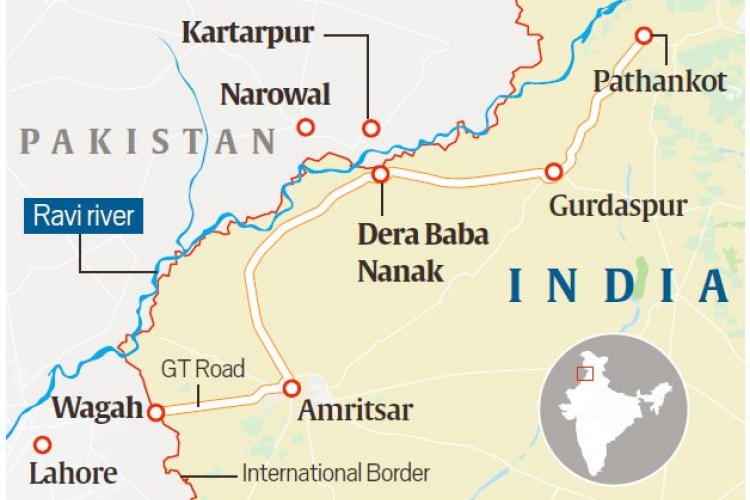KARTAPUR CORRIDOR
IN NEWS
In a significant decision, the Union Cabinet approved the building and developm0ent of the Kartarpur corridor from Dera Baba Nanak in Gurdaspur district to the international border, in order to facilitate pilgrims from India to visit Gurdwara Darbar Sahib Kartarpur on the banks of the Ravi river, in Pakistan, where Shri Guru Nanak Devji spent eighteen years. Pilgrims would then be able to visit the holy shrine throughout the year.
KARTAPUR CORRIDOR
There have long been demands from the Shiromani Gurdwara Parbandhak Committee and political leaders to build a “corridor” flanked by barbed wire to allow pilgrims to cross over into Pakistan to visit the Kartarpur Sahib shrine, and return the same day. A bridge will need to be constructed over the Ravi, and there shall be no need for passports or visas.
SHRINE AND PILGRIMS
The gurdwara in Kartarpur stands on the bank of the Ravi, about 120 km northeast of Lahore. It was here that Guru Nanak assembled a Sikh community and lived for 18 years until his death in 1539. The shrine is visible from the Indian side, as Pakistani authorities generally trim the elephant grass that would otherwise obstruct the view. Indian Sikhs gather in large numbers for darshan from the Indian side, and binoculars are installed at Gurdwara Dera Baba Nanak.
The gurdwara was opened to pilgrims after repairs and restoration in 1999, and Sikh jathas have been visiting the shrine regularly ever since. This was one of the outcomes of the historic bus trip to Lahore by Prime Minister Atal Bihari Vajpayee in February 1999, and there are no restrictions on visiting Gurdwara Kartarpur Sahib once a pilgrim has entered Pakistan on a valid visa. Sikh jathas from India travel to Pakistan on four occasions every year — for Baisakhi, the martyrdom day of Guru Arjan Dev, the death anniversary of Maharaja Ranjit Singh, and the birthday of Guru Nanak Dev. These Indian pilgrims are given access to all gurdwaras in Pakistan.
SIGNIFICANCE OF THE CORRIDOR INITIATIVE
The setting up of a corridor from the international border up to the gurdwara is expected to reduce bitterness among the two hostile nations. The corridor will also work as a peace point.
The government could win the goodwill of the Sikh community by agreeing to the demand.
As India and Pakistan celebrate 71 years of independence, Gurdwara Darbar Sahib, Kartarpur, is just one illustration of how Partition led not just to mass migration and personal tragedies, but also how communities were separated from their historic religious shrines.
Hence, The Guru’s 550th year celebrations provides a good opportunity for both the Pakistani and Indian governments to work together and set up a religious corridor.
CONCERN OF THE KARTAPUR CORRIDOR
The “corridor” would bring Pak infrastructure right up to the Indian border. Over the past year, gurdwaras in Pakistan have been used for a pro-Khalistan campaign. Earlier this year, a gurdwara displayed posters and distributed pamphlets for the so-called “Sikh Referendum 2020”, and Pakistan denied permission to the Indian envoy and diplomats to visit it. Pakistan’s intent also remains suspect, and Indian officials are wary of the corridor being misused by both state and non-state actors in that country.


 IAS -2025 Prelims Combined Mains Batch - III Starts - 14-04-2024
IAS -2025 Prelims Combined Mains Batch - III Starts - 14-04-2024